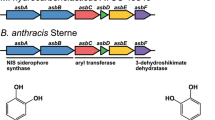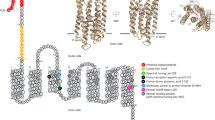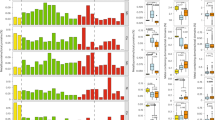Abstract
Primary productivity in 30–40% of the world’s oceans is limited by availability of the micronutrient iron1,2. Regions with chronically low iron concentrations are sporadically pulsed with new iron inputs by way of dust3 or lateral advection from continental margins4. Addition of iron to surface waters in these areas induces massive phytoplankton blooms dominated primarily by pennate diatoms5,6. Here we provide evidence that the bloom-forming pennate diatoms Pseudo-nitzschia and Fragilariopsis use the iron-concentrating protein, ferritin, to safely store iron. Ferritin has not been reported previously in any member of the Stramenopiles, a diverse eukaryotic lineage that includes unicellular algae, macroalgae and plant parasites. Phylogenetic analyses suggest that ferritin may have arisen in this small subset of diatoms through a lateral gene transfer. The crystal structure and functional assays of recombinant ferritin derived from Pseudo-nitzschia multiseries reveal a maxi-ferritin that exhibits ferroxidase activity and binds iron. The protein is predicted to be targeted to the chloroplast to control the distribution and storage of iron for proper functioning of the photosynthetic machinery. Abundance of Pseudo-nitzschia ferritin transcripts is regulated by iron nutritional status, and is closely tied to the loss and recovery of photosynthetic competence. Enhanced iron storage with ferritin allows the oceanic diatom Pseudo-nitzschia granii to undergo several more cell divisions in the absence of iron than the comparably sized, oceanic centric diatom Thalassiosira oceanica. Ferritin in pennate diatoms probably contributes to their success in chronically low-iron regions that receive intermittent iron inputs, and provides an explanation for the importance of these organisms in regulating oceanic CO2 over geological timescales7,8.
This is a preview of subscription content, access via your institution
Access options
Subscribe to this journal
Receive 51 print issues and online access
$199.00 per year
only $3.90 per issue
Buy this article
- Purchase on Springer Link
- Instant access to full article PDF
Prices may be subject to local taxes which are calculated during checkout




Similar content being viewed by others
Accession codes
Primary accessions
GenBank/EMBL/DDBJ
Protein Data Bank
Data deposits
All sequences have been deposited in GenBank under accession codes FJ004953–FJ004969 and are listed in Supplementary Table 2. The coordinates of the apo and iron-soaked ferritin structures have been deposited in the Protein Data Bank under respective accession numbers 3E6R and 3E6S.
References
Martin, J. H. & Fitzwater, S. Iron deficiency limits phytoplankton growth in the north-east Pacific subarctic. Nature 331, 341–343 (1988)
Moore, J. K., Doney, S. C., Glover, D. M. & Fung, I. Y. Iron cycling and nutrient-limitation patterns in surface waters of the World Ocean. Deep-Sea Res. II 49, 463–507 (2002)
Jickells, T. D. et al. Global iron connections between desert dust, ocean biogeochemistry, and climate. Science 308, 67–71 (2005)
Lam, P. J. & Bishop, J. K. B. The continental margin is a key source of iron to the HNLC North Pacific Ocean. Geophys. Res. Lett. 35 L07608 doi: 10.1029/2008GL033294 (2008)
Marchetti, A., Sherry, N. D., Kiyosawa, H., Tsuda, A. & Harrison, P. J. Phytoplankton processes during a mesoscale iron enrichment in the NE subarctic Pacific: Part I – biomass and assemblage. Deep-Sea Res. II 53, 2095–2113 (2006)
de Baar, H. J. W. et al. Synthesis of iron fertilization experiments: From the iron age in the age of enlightenment. J. Geophys. Res. 110 C09S16 doi: 10.1029/2004JC002601 (2005)
Cortese, G. & Gersonde, R. Morphometric variability in the diatom Fragilariopsis kerguelensis: Implications for Southern Ocean paleoceanography. Earth Planet. Sci. Lett. 257, 526–544 (2007)
Katsuki, K. & Takahashi, K. Diatoms as paleoenvironmental proxies for seasonal productivity, sea-ice and surface circulation in the Bering Sea during the late Quaternary. Deep-Sea Res. II 52, 2110–2130 (2005)
Liu, X. & Theil, E. C. Ferritins: Dynamic management of biological iron and oxygen chemistry. Acc. Chem. Res. 38, 167–175 (2005)
Gruber, A. et al. Protein targeting into complex diatom plastids: functional characterisation of a specific targeting motif. Plant Mol. Biol. 64, 519–530 (2007)
Jin, W., Takagi, H., Pancorbo, B. & Theil, E. C. “Opening” the ferritin pore for iron release by mutation of conserved amino acids at interhelix and loop sites. Biochemistry 40, 7525–7532 (2001)
Yang, X. O., Chen-Barret, Y., Arosio, P. & Chasteen, N. D. Reaction paths of iron oxidation and hydrolysis in horse spleen and recombinant human ferritins. Biochemistry 37, 9743–9750 (1998)
Xu, B. & Chasteen, N. D. Iron-oxidation chemistry in ferritin. J. Biol. Chem. 266, 19965–19970 (1991)
Bou-Abdallah, F., Lewin, A. C., Le Brun, N. E., Moore, G. R. & Chasteen, N. D. Iron detoxification properties of Escherichia coli bacterioferritin — Attenuation of oxyradical chemistry. J. Biol. Chem. 277, 37064–37069 (2002)
Yang, X., Chiacone, E., Stefanini, S., llari, A. & Chasteen, N. D. Iron oxidation and hydrolysis reactions of a novel ferritin from Listeria innocua . Biochem. J. 349, 783–786 (2000)
Marchetti, A., Maldonado, M. T., Lane, E. S. & Harrison, P. J. Iron requirements of the pennate diatom Pseudo-nitzschia: Comparison of oceanic (HNLC) and coastal species. Limnol. Oceanogr. 51, 2092–2101 (2006)
Sunda, W. G., Swift, D. G. & Huntsman, S. A. Low iron requirement for growth in oceanic phytoplankton. Nature 351, 55–57 (1991)
Bowie, A. R. et al. The fate of added iron during a mesoscale fertilisation experiment in the Southern Ocean. Deep-Sea Res. II 48, 2703–2743 (2001)
La Fontaine, S. et al. Copper-dependent iron assimilation pathway in the model photosynthetic eukaryote Chlamydomonas reinhardtii . Eukaryot. Cell 1, 736–757 (2002)
Phaeodactylum. tricornutum v2.0. 〈http://genome.jgi-psf.org/Phatr2/Phatr2.home.html〉 (2006)
Armbrust, E. V. et al. The genome of the diatom Thalassiosira pseudonana: Ecology, evolution, and metabolism. Science 306, 79–86 (2004)
Sims, P. A., Mann, D. G. & Medlin, L. K. Evolution of the diatoms: Insights from fossil, biological and molecular data. Phycologia 45, 361–402 (2006)
Andersson, J. O. Lateral gene transfer in eukaryotes. Cell. Mol. Life Sci. 62, 1182–1197 (2005)
Kustka, A. B., Allen, A. E. & Morel, F. M. M. Sequence analysis and transcriptional regulation of iron acquisition genes in two marine diatoms. J. Phycol. 43, 715–729 (2007)
Maldonado, M. T. & Price, N. M. Influence of N substrate on Fe requirements of marine centric diatoms. Mar. Ecol. Prog. Ser. 141, 161–172 (1996)
Sunda, W. & Huntsman, S. A. Iron uptake and growth limitation in oceanic and coastal phytoplankton. Mar. Chem. 50, 189–206 (1995)
Acknowledgements
We thank S. S. Bates for providing P. multiseries CLN-47 and CLN-17 isolates used in this study, and T. Rynearson for sea water from OSP in which P. granii (UWOSP36) was isolated. We are grateful to K. R. Boissonneault for providing P. multiseries actin sequences, R. Marohl and I. Oleinkov for assistance with culture maintenance and sample analyses, and W. C. Lee for assistance with X-ray diffraction data collection. This study was supported by a Gordon and Betty Moore Foundation Marine Microbiology Investigator Award, National Science Foundation grants and a National Institute of Environmental Health Sciences grant to E.V.A.; a National Sciences and Engineering Research Council of Canada grant to M.T.M.; and a Canadian Institutes of Health Research grant to M.E.P.M. Portions of this research were carried out at the Canadian Light Source (CLS) and the Stanford Synchrotron Radiation Laboratory (SSRL). SSRL is a national user facility operated by Stanford University on behalf of the US Department of Energy, Office of Basic Energy Sciences. The SSRL Structural Molecular Biology Program is supported by the Department of Energy, Office of Biological and Environmental Research, and by the National Institutes of Health, National Center for Research Resources, Biomedical Technology Program, and the National Institute of General Medical Sciences.
Author Contributions A.M., M.S.P. and E.V.A. designed the study; A.M. and M.S.P. performed the FTN annotation, phylogeny analyses and conducted the FTN expression and continuous culture experiments; M.E.P.M. and M.T.M. guided—and L.P.M. and A.A. conducted—the ferritin protein crystallography and biochemical characterization experiments; E.O.L. assisted with sequencing and performed FTN surveys; F.R. performed flow cytometry analyses and assisted with culture experiments; A.M. wrote the paper with assistance from E.V.A., M.S.P., L.P.M., M.T.M., A.A. and M.E.P.M. All authors discussed the results and commented on the manuscript.
Author information
Authors and Affiliations
Corresponding author
Supplementary information
Supplementary Information
This file contains Supplementary Tables S1-S6, Supplementary Figures S1-S7 and Legends, Supplementary Notes S1-S4, Supplementary Methods and Supplementary References. (PDF 1296 kb)
Rights and permissions
About this article
Cite this article
Marchetti, A., Parker, M., Moccia, L. et al. Ferritin is used for iron storage in bloom-forming marine pennate diatoms. Nature 457, 467–470 (2009). https://doi.org/10.1038/nature07539
Received:
Accepted:
Published:
Issue Date:
DOI: https://doi.org/10.1038/nature07539
This article is cited by
-
Numerical Investigation of Solid–Liquid Dissolution for Nutrient Mixing Improvement in a Thin-Layer Cascade System
Waste and Biomass Valorization (2024)
-
First report on biological iron uptake in the Antarctic sea-ice environment
Polar Biology (2023)
-
Iron uptake, transport and storage in marine brown algae
BioMetals (2023)
-
Bioavailable iron titrations reveal oceanic Synechococcus ecotypes optimized for different iron availabilities
ISME Communications (2022)
-
Diminished carbon and nitrate assimilation drive changes in diatom elemental stoichiometry independent of silicification in an iron-limited assemblage
ISME Communications (2022)
Comments
By submitting a comment you agree to abide by our Terms and Community Guidelines. If you find something abusive or that does not comply with our terms or guidelines please flag it as inappropriate.



